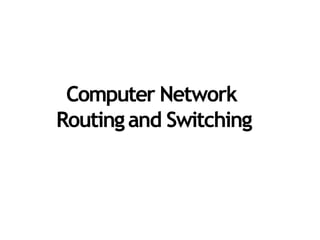
Routing and switching
- 2. Routing • A Router is a process of selecting path along which the data can be transferred from source to the destination. Routing is performed by a special device known as a router. • A Router works at the network layer in the OSI model and internet layer in TCP/IP model • The routing algorithms are used for routing the packets. The routing algorithm is nothing but a software responsible for deciding the optimal path through which packet can be transmitted.
- 3. Types Of Routing • Routing can be classified into three categories:-
- 4. Static Routing is also known as Nonadaptive Routing. It is a technique in which the administrator manually adds the routes in a routing table. A Router can send the packets for the destination along the route defined by the administrator. In this technique, routing decisions are not made based on the condition or topology of the networks 1. Static Routing
- 5. 2. Dynamic Routing • It is also known as Adaptive Routing. • It is a technique in which a router adds a new route in the routing table for each packet in response to the changes in the condition or topology of the network. • Dynamic protocols are used to discover the new routes to reach the destination. • In Dynamic Routing, RIP and OSPF are the protocols used to discover the new routes. • If any route goes down, then the automatic adjustment will be made to reach the destination.
- 6. 3. Default Routing • Default Routing is a technique in which a router is configured to send all the packets to the same hop device, and it doesn't matter whether it belongs to a particular network or not. A Packet is transmitted to the device for which it is configured in default routing. • Default Routing is used when networks deal with the single exit point. • It is also useful when the bulk of transmission networks have to transmit the data to the same hp device.
- 7. Switching • Switch: A switch is a small hardware device which is used to join multiple computers together with one local area network (LAN). • Switching: Switching in a computer network is achieved by using switches. • When a user accesses the internet or another computer network outside their immediate location, messages are sent through the network of transmission media. This technique of transferring the information from one computer network to another network is known as switching. • Network switches operate at layer 2 (Data link layer) in the OSI model.
- 8. The layer 2 switches are used for transmitting the data on the data link layer, and it also performs error checking on transmitted and received frames. Different modes are used for forwarding the packets known as Switching modes. There are three types of switching modes: 1) Store-and-forward 2) Cut-through 3) Fragment-free Switching Modes
- 10. 1. CIRCUIT-SWITCHEDNETWORKS • Circuit switching is a switching technique that establishes a dedicated path between sender and receiver. • In the Circuit Switching Technique, once the connection is established then the dedicated path will remain to exist until the connection is terminated. • Circuit switching in a network operates in a similar way as the telephone works. • Each link is divided into channels using FDM or TDM.
- 11. Three phases are need to communicate two parties or multiple parties in aconferencecall): • Connection setup • data transfer • Circuit Disconnected
- 12. 2.PACKETSWITCHED NETWORK • The packet switching is a switching technique in which the message is sent in one go, but it is divided into smaller pieces, and they are sent individually. • Packets are given a unique number to identify their order at the receiving end. • Every packet contains some information in its headers such as source address, destination address and sequence number. • Packets will travel across the network, taking the shortest path as possible. • If the correct order of the packets is reached, then the acknowledgment message will be sent.
- 13. 2.1DATAGRAM NETWORKS • Each packet (called as datagrams in this approach) is treated independently of allothers. • All packets (or datagrams) belong to the samemessagemay travel. different pathsto reachtheir destination.
- 14. 2.2VIRTUAL-CIRCUIT NETWORKS • It’s a cross between circuit switched network and datagram network, and hassome characteristics of both. Characteristics: Packets from asingle messagetravel along the same path. Three phasesto transfer data (set up, data transfer andtear down) Resourcescanbe allocated during setup phase Data are packetized and each packet carries an address in the header Implemented in data linklayer
- 15. 3. Message Switching • Message Switching is a switching technique in which a message is transferred as a complete unit and routed through intermediate nodes at which it is stored and forwarded. • In Message Switching technique, there is no establishment of a dedicated path between the sender and receiver. • Each and every node stores the entire message and then forward it to the next node. This type of network is known as store and forward network.
- 16. Advantages and Disadvantages of Switching:- •Advantages:- • Switch increases the bandwidth of the network. • It reduces the workload on individual PCs as it sends the information to only that device which has been addressed. • It increases the overall performance of the network by reducing the traffic on the network. • There will be less frame collision as switch creates the collision domain for each connection.
- 17. Disadvantages:- • A Switch is more expensive than network bridges. • A Switch cannot determine the network connectivity issues easily. • Proper designing and configuration of the switch are required to handle multicast packets.
- 18. ThankYou…